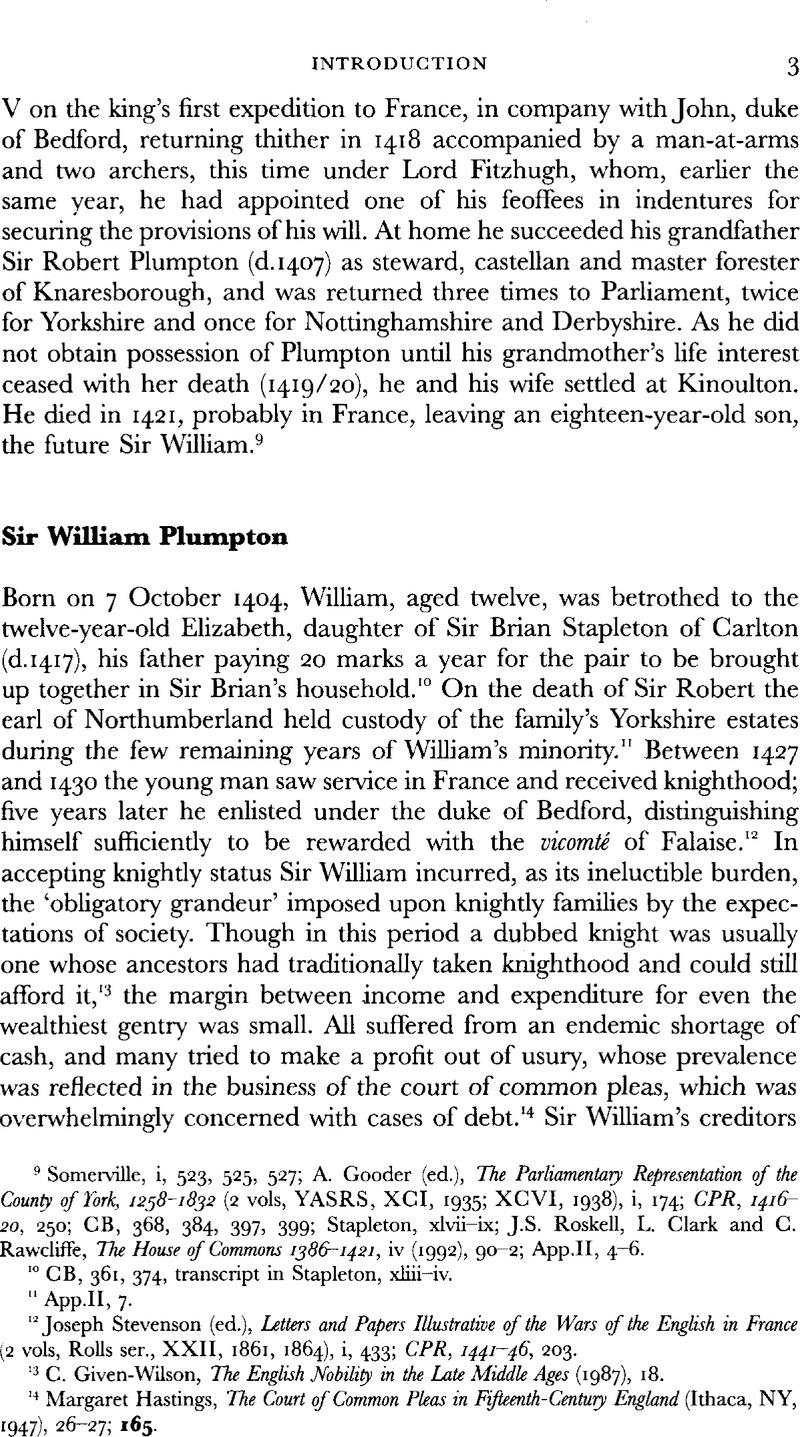No CrossRef data available.
Article contents
Sir William Plumpton
Published online by Cambridge University Press: 13 October 2009
Abstract

- Type
- Introduction
- Information
- Copyright
- Copyright © Royal Historical Society 1996
References
10 CB, 361, 374, transcript in Stapleton, , xliii–iv.Google Scholar
11 App.II, 7.
12 Stevenson, Joseph (ed.), Letters and Papas Illustrative of the Wars of the English in France (2 vols, Rolls ser., XXII, 1861, 1864), i, 433Google Scholar; CPR, 1441–46, 203.Google Scholar
13 Given-Wilson, C., The English Nobility in the Late Middle Ages (1987), 18.Google Scholar
14 Hastings, Margaret, The Court of Common Pleas in Fifteenth-Century England (Ithaca, NY, 1947), 26–27Google Scholar; 165.
15 E.g. 6–8; CPR, 1467–77, 327Google Scholar; ibid., 1476–85, 185; Kirby, Joan W., ‘A Fifteenth-Century Family, The Plumptons of Plumpton and their Lawyers’, NH, xxv (1989), 107–8.Google Scholar
16 The licence for crenellation and emparkment is dated 17 Feb. 1473, CB, 585.
17 The chapel at Plumpton, dedicated to the Holy Trinity, was said to be near the manor house, Test. Ebor., iii, 335, 209Google Scholar. Sir William Plumpton (d.1362) founded a chantry dedicated to the Holy Trinity behind the high altar in the minster church of Ripon, App.II, 1. Ellen de Gisburn, mother of Alice Plumpton, widow of Sir William (exec.1405), founded the chantry of the Blessed Nicholas in St Martin's church, Micklegate, York in May 1396, App.II, 2. In his will, dated 14 Nov. 1450, George Plumpton, clerk, endowed a chantry at the altar of St Mary Magdalene at the east end of the north aisle of the nave in the parish church of Spofforth, known as the Plumpton Quire, CB, 520; Kirk, George E., The Parish Church of All Hallows (All Saints), Spofforth, Yorkshire, and the Chapels of Follifoot, Little Ribston, Plumpton and Stockeld (Shipley, 1958), 12–13Google Scholar; University of Leeds, Brotherton Library, Archives of the Dean and Chapter of Ripon, MSS, 1.1.
18 CB, 541, 570, 555, 579, 534; App.II, 11, 13, 17.
19 18, 27, 28; CPR, 1467–77, 327Google Scholar; ibid., 1476–85, 185.
30 CB, 437; App.I, 2.
31 App.II, 16. There is no record of the second marriage in the CB.
22 See below, p.9.
23 DNB; Somerville, , i, 524, 525Google Scholar; App.II, 10, 12. He had been granted the stewardship etc. of Knaresborough for life, RP, v, 347Google Scholar. Until 1308/9, when they acquired Alnwick, Spofforth had been the caput of the Percys' northern estates, Fisher, E.J., ‘Some Yorkshire Estates of the Percy Family 1416–1537’ (unpub. Ph.D. thesis, University of Leeds, 2 vols 1955), i, 12.Google Scholar
24 CPR, 1436–41, 594Google Scholar; ibid., 1441–46, 482; ibid., 1446–52, 598; ibid., 1452–61, 683; ibid., 1467–77, 638; ibid., 1476–85, 579–80; Arnold, Carol, ‘The Commission of the Peace of the West Riding of Yorkshire’, in Griffiths, R.A. and Sherborne, James (eds), Kings and Nobles in the Later Middle Ages: A Tribute to Charles Ross (Gloucester, 1986), 119–20.Google Scholar
25 Return of Members of Parliament, 330Google Scholar; Storey, R.L., The End of the House of Lancaster (1966), 160–1.Google Scholar
26 A List of Sheriffs for England and Wales (PRO, Lists and Indexes, ix, 1898), 103, 162.Google Scholar
27 CPR, 1429–36, 520Google Scholar; ibid., 1441–46, 369; ibid., 1446–52, 88; ibid., 1452–61, 408, 560; ibid., 1467–77, 55, 349, 355, 408, 572; ibid., 1476–85, 50; CFR, 1430–32, 350, 355Google Scholar; ibid., 1445–52, 169; CB, 545 (enquiry concerning the lands of the attainted Richard, duke of York, 1 May 1460).
28 Storey, , 194Google Scholar; Jalland, P., ‘The Influence of the Aristocracy on Shire Elections’, Speculum, xlvii (1972), 47, 487Google Scholar; CCR, 1461–68, 135.Google Scholar
29 Pullein, Catherine, The Pulleins of Yorkshire (Leeds, 1915), 45Google Scholar; Griffiths, R.A., The Reign of Henry VI: The Exercise of Royal Authority, 1422–1461 (1981), 578Google Scholar; CCR, 1441–47, 98Google Scholar; ibid., 1454–61, 101; CB, 455–58. There is a transcript of this account of the riots in Stapleton, liv–lxii.
30 Wright, Susan, The Derbyshire Gentry in the Fifteenth Century (Derbyshire Record Society, VIII, 1983), 75, 101Google Scholar; Dockray, Keith, ‘Sir Marmaduke Constable of Flamborough’, in Petre, J. (ed.), Richard III, Crown and People (Richard III Society, 1985), 218Google Scholar; Carpenter, Christine, Locality and Polity, 498–514.Google Scholar
31 Arnold, , 122, 125–6Google Scholar; Lander, J.R., English Justices of the Peace, 1461–1509 (1989), 44.Google Scholar
32 CB, 549 (recognizance, 13 May 1461), 550 (imprisonment, 12 July 1461), transcripts in Stapleton, lxviii and n. He was said to have been captured by the earl of Warwick, Gairdner, James (ed.), Three Fifteenth-Century Chronicles (Camden Society, 2nd ser., XXVIII, 1880), 161.Google Scholar
33 8 App.II, 19.
34 App.II, 26.
35 Pollard, A.J., North-Eastern England During the Wars of the Roses (Oxford, 1990), 288–9, 293.Google Scholar
36 Fisher, E.J., ‘Some Yorkshire Estates of the Percy Family’, i, 36Google Scholar; CPR, 1461–67, 39.Google Scholar
37 Bruce, J. (ed.), Historie of the Arrivall of Edward IV in England and the Finall Recouerye of his Kingdomes from Henry VI A.D. Mcccclxxi (Camden Society, I, 1838), 7Google Scholar. Pollard suggests that Sir William's dismissal followed Warwick's loss of office, NE England, 139Google Scholar. He received a pardon for offences committed before 30 Sept. 1471, CB, 578, transcript in Stapleton, lxxv n.
38 28, 29
39 App.I, 3; II, 23.
40 See below, p. 14.
41 App.II, 30.
42 CB, 582, 631, transcripts in Stapleton, , lxxvi–vii.Google Scholar
43 App.II, 33.
44 App.II, 35, 36.
45 App.II, 37.
46 App.II, 38, 39.




